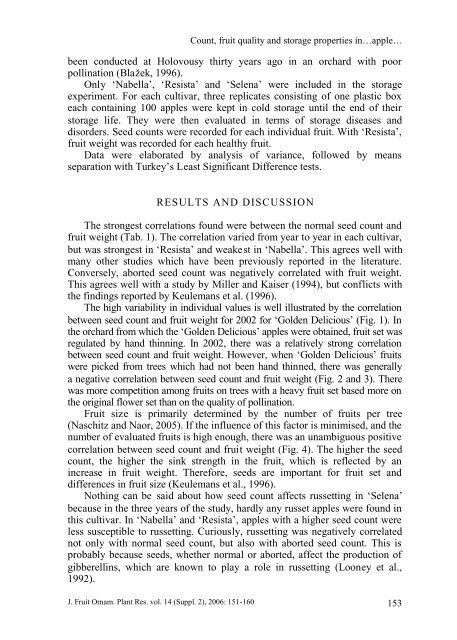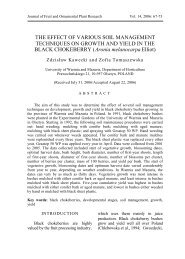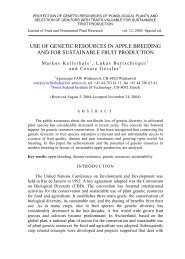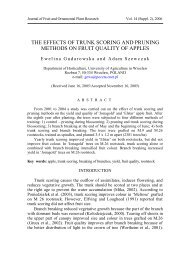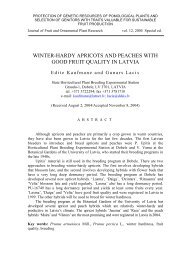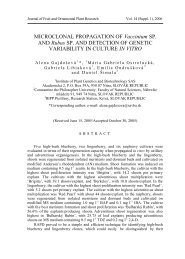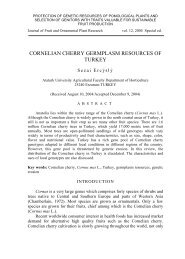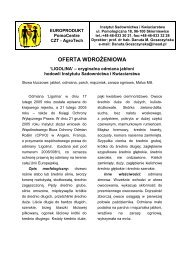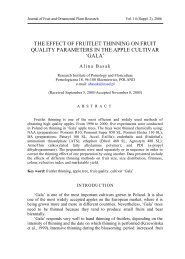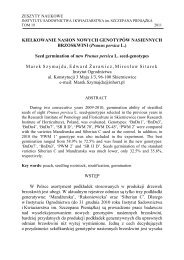seed count, fruit quality and storage properties in four apple cultivars
seed count, fruit quality and storage properties in four apple cultivars
seed count, fruit quality and storage properties in four apple cultivars
Create successful ePaper yourself
Turn your PDF publications into a flip-book with our unique Google optimized e-Paper software.
Count, <strong>fruit</strong> <strong>quality</strong> <strong>and</strong> <strong>storage</strong> <strong>properties</strong> <strong>in</strong>…<strong>apple</strong>…<br />
been conducted at Holovousy thirty years ago <strong>in</strong> an orchard with poor<br />
poll<strong>in</strong>ation (Blažek, 1996).<br />
Only ‘Nabella’, ‘Resista’ <strong>and</strong> ‘Selena’ were <strong>in</strong>cluded <strong>in</strong> the <strong>storage</strong><br />
experiment. For each cultivar, three replicates consist<strong>in</strong>g of one plastic box<br />
each conta<strong>in</strong><strong>in</strong>g 100 <strong>apple</strong>s were kept <strong>in</strong> cold <strong>storage</strong> until the end of their<br />
<strong>storage</strong> life. They were then evaluated <strong>in</strong> terms of <strong>storage</strong> diseases <strong>and</strong><br />
disorders. Seed <strong>count</strong>s were recorded for each <strong>in</strong>dividual <strong>fruit</strong>. With ‘Resista’,<br />
<strong>fruit</strong> weight was recorded for each healthy <strong>fruit</strong>.<br />
Data were elaborated by analysis of variance, followed by means<br />
separation with Turkey’s Least Significant Difference tests.<br />
RESULTS AND DISCUSSION<br />
The strongest correlations found were between the normal <strong>seed</strong> <strong>count</strong> <strong>and</strong><br />
<strong>fruit</strong> weight (Tab. 1). The correlation varied from year to year <strong>in</strong> each cultivar,<br />
but was strongest <strong>in</strong> ‘Resista’ <strong>and</strong> weakest <strong>in</strong> ‘Nabella’. This agrees well with<br />
many other studies which have been previously reported <strong>in</strong> the literature.<br />
Conversely, aborted <strong>seed</strong> <strong>count</strong> was negatively correlated with <strong>fruit</strong> weight.<br />
This agrees well with a study by Miller <strong>and</strong> Kaiser (1994), but conflicts with<br />
the f<strong>in</strong>d<strong>in</strong>gs reported by Keulemans et al. (1996).<br />
The high variability <strong>in</strong> <strong>in</strong>dividual values is well illustrated by the correlation<br />
between <strong>seed</strong> <strong>count</strong> <strong>and</strong> <strong>fruit</strong> weight for 2002 for ‘Golden Delicious’ (Fig. 1). In<br />
the orchard from which the ‘Golden Delicious’ <strong>apple</strong>s were obta<strong>in</strong>ed, <strong>fruit</strong> set was<br />
regulated by h<strong>and</strong> th<strong>in</strong>n<strong>in</strong>g. In 2002, there was a relatively strong correlation<br />
between <strong>seed</strong> <strong>count</strong> <strong>and</strong> <strong>fruit</strong> weight. However, when ‘Golden Delicious’ <strong>fruit</strong>s<br />
were picked from trees which had not been h<strong>and</strong> th<strong>in</strong>ned, there was generally<br />
a negative correlation between <strong>seed</strong> <strong>count</strong> <strong>and</strong> <strong>fruit</strong> weight (Fig. 2 <strong>and</strong> 3). There<br />
was more competition among <strong>fruit</strong>s on trees with a heavy <strong>fruit</strong> set based more on<br />
the orig<strong>in</strong>al flower set than on the <strong>quality</strong> of poll<strong>in</strong>ation.<br />
Fruit size is primarily determ<strong>in</strong>ed by the number of <strong>fruit</strong>s per tree<br />
(Naschitz <strong>and</strong> Naor, 2005). If the <strong>in</strong>fluence of this factor is m<strong>in</strong>imised, <strong>and</strong> the<br />
number of evaluated <strong>fruit</strong>s is high enough, there was an unambiguous positive<br />
correlation between <strong>seed</strong> <strong>count</strong> <strong>and</strong> <strong>fruit</strong> weight (Fig. 4). The higher the <strong>seed</strong><br />
<strong>count</strong>, the higher the s<strong>in</strong>k strength <strong>in</strong> the <strong>fruit</strong>, which is reflected by an<br />
<strong>in</strong>crease <strong>in</strong> <strong>fruit</strong> weight. Therefore, <strong>seed</strong>s are important for <strong>fruit</strong> set <strong>and</strong><br />
differences <strong>in</strong> <strong>fruit</strong> size (Keulemans et al., 1996).<br />
Noth<strong>in</strong>g can be said about how <strong>seed</strong> <strong>count</strong> affects russett<strong>in</strong>g <strong>in</strong> ‘Selena’<br />
because <strong>in</strong> the three years of the study, hardly any russet <strong>apple</strong>s were found <strong>in</strong><br />
this cultivar. In ‘Nabella’ <strong>and</strong> ‘Resista’, <strong>apple</strong>s with a higher <strong>seed</strong> <strong>count</strong> were<br />
less susceptible to russett<strong>in</strong>g. Curiously, russett<strong>in</strong>g was negatively correlated<br />
not only with normal <strong>seed</strong> <strong>count</strong>, but also with aborted <strong>seed</strong> <strong>count</strong>. This is<br />
probably because <strong>seed</strong>s, whether normal or aborted, affect the production of<br />
gibberell<strong>in</strong>s, which are known to play a role <strong>in</strong> russett<strong>in</strong>g (Looney et al.,<br />
1992).<br />
J. Fruit Ornam. Plant Res. vol. 14 (Suppl. 2), 2006: 151-160 153


